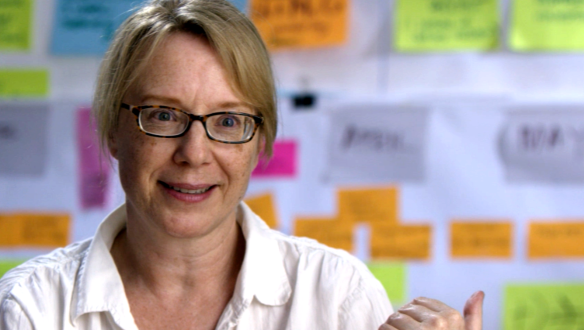
The Institute for the Future (IFTF), an independent, 50-person non-profit research group dedicated to helping all types of organizations “make the futures they want” has been using Beam (Plus and Pro models) now for a little over a year. Beam allows remote staff, affiliates, clients and others to meet in person — and is a very real expression of how the futurist think tank practices what it researches and teaches.
One of the biggest questions when using Beam, according to cultural anthropologist Lyn Jeffery, Research Director in the Ten-Year Forecast Program, was, “How can I instantiate myself in order to have the desired effect for optimal collaboration, productivity, etc.?”
As it is with human beings, the answer had a lot to do with interpersonal interactions, particularly how to reinterpret manners and social mores for Smart Presence. IFTF staff, including Jeffery and her associate, researcher Rachel Hatch, among others, enjoyed getting creative with workarounds and solutions to ensure a thoughtful telepresence.
HOW TO BE THE ROBOT HOST(ESS) WITH THE MOST(ESS)
While it’s easy to roll over to greet guests, show them around the office or escort them to the bathroom when you’re using a Beam, actual hospitality is much trickier. For example, you can’t hand them a parking pass or set out coffee and snacks for them. IFTF researcher Rachel Hatch’s solution? She experimented with Instacart delivery and other services that can be ordered online or over the phone and delivered right to meetings.
FIND A BUDDY, BUT BE CLEAR: SHE’S NOT A BABYSITTER OR BUTLER
In the hospitality example above, another solution would of course to have a human counterpart help out with greeting guests and making them comfortable. This, according to Hatch, can create an opportunities for “new kinds of partnerships,” where the buddy acts as hands for the Beam user. It has a big caveat, however – you don’t want to create for your buddy too much “office housework,” which is the thankless but necessary tasks required to keep things organized and running smoothly at work. This includes things like opening doors or moving heavy obstacles that Beam can’t itself move out of the way or maneuver around. Some help is fine, but be thoughtful and streamline when and where you can.
USE YOUR INSIDE VOICE
While remote users can easily control the volume on their computers when using the Beam, it doesn’t necessarily mean that it’s at a level that works well for those on the receiving end. For example, Jeffery found that when she tried to speak to a co-worker in a room near a loud air conditioning unit, her voice was too soft so she had to raise the volume. Later, when she rolled to another part of the office, she was then too loud. Back to the buddy system: it’s helpful to have someone let you know when you need to regulate your volume. Or at the very least, remember to ask the people you’re addressing when you enter a new room if you sound okay or if you need to make adjustments.
DON’T BE A NOSY NEIGHBOR
When you Beam, you’re generally pretty much silent, so always remember to say “hi” when you roll up to a co-worker. But that’s just the starting place – Hatch had a situation where she Beamed into a room where someone had left the apparatus (vs. bringing it to its base station) and she ended up “blinking to life” in the middle of a meeting between two colleagues — who may not have appreciated her unexpected pop in. It’s important to keep in mind that turning off the telepresence isn’t the same as leaving the space.
These examples are all great reminders, thanks to IFTF, that nobody likes a rude robot. Always remember your social graces are an important part having not just a smart, but also a sensitive presence.